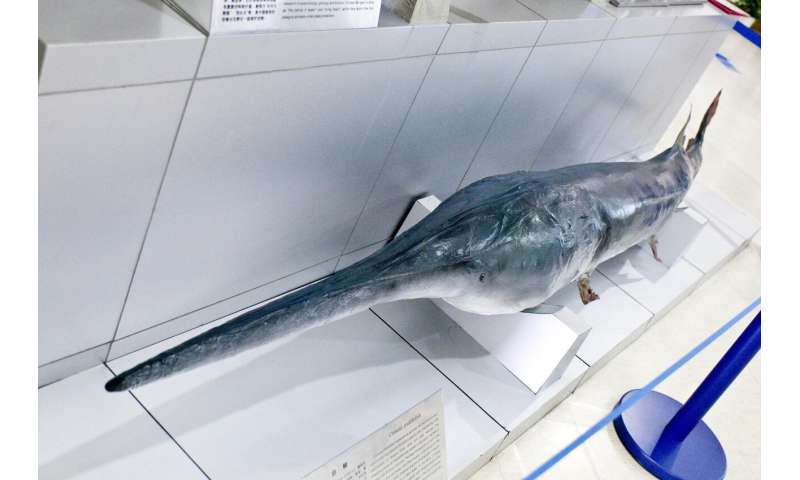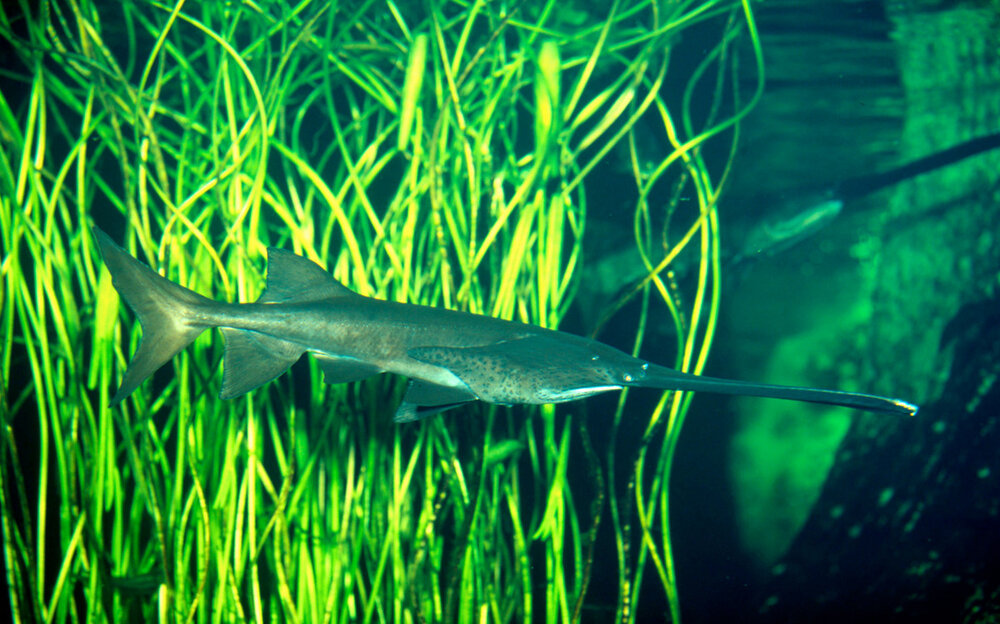Researchers announce extinction of the Chinese paddlefish
The paper well illustrates the factors behind the disappearance of the Chinese Paddlefish; and they sound all too familiar to those affecting sturgeon in other rivers such as the Danube. Credit: Flickr Biosiversity Photo Database, Yangtze Museum

The new decade 2020 began with the sad announcement that another species is now extinct—the Chinese Paddlefish (Psephurus gladius), a close relative of the sturgeon family. A paper by Chinese scientists concluded (based on IUCN criteria) that after 200 million years, the "Panda of the Yangtze" which reached up to 7m is now gone from the Yangtze forever. Although the paper received wide coverage in international media, unfortunately it only marked the scientific notification of a fate already sealed and known for some time. In fact, the authors estimated that the paddlefish went extinct somewhere in 2005–2010. The last time a live specimen was found was in 2003. Ten years before that (1993), scientists announced that the species was already "functionally extinct," meaning that for lack of mates it could not reproduce anymore. Therefore, the newest paper did not write a surprise ending for this sad story. Experts have been well aware of the situation for many years.
The paper well illustrates the factors behind the disappearance of the Chinese Paddlefish; and they sound all too familiar to those affecting sturgeon in other rivers such as the Danube. In particular, the combined effects of overfishing and the disruption of migration routes by both small and large dams without proper consideration for fish migration continue to have severe negative impacts on these species. On the Danube, the situation is best represented by the Iron Gates Dams.
The Chinese paddlefish population has been in gradual decline over the last century. Even so, until the 1970's, up to 25 tons of paddlefish were still harvested annually. When the Three Gorges and Gezhouba Dams were constructed on the Yangtze River in the 1980s without any fish passes, they cut off the paddlefish spawning grounds and sealed their fate.
The Danube River, which was historically the home to six distinct sturgeon species, is no exception to this repeating story. The European Atlantic sturgeon (Acipenser sturio) already disappeared long time ago from its entire Black Sea range. The last specimen was found in 1991 in the Rioni River in Georgia. This sturgeon is also sometimes referred to as the common sturgeon, since it was once found all across Europe. Today it is extirpated from all its entire range except in the Gironde-Dordogne-Garonne Basin in France. Less than 800 wild common sturgeons are thought to survive. A breeding and release programme is in place, but due to a very low number of fish in the breeding stock, it has not been very effective.

When the Three Gorges and Gezhouba Dams were constructed without any fish passes, they cut off the paddlefish spawning grounds. Credit: Flickr Biosiversity Photo Database, Liu Chen Han
Action might also come too late for the ship sturgeon, another species once native to the Danube River system. Given that only three known specimens have been caught since 2000, most experts consider the ship sturgeon functionally extinct in the Danube River Basin.
Down from six to four!? None of the four remaining Danube sturgeon species are doing great either. If anything, these past stories should be ringing alarm bells in Europe, and in particular in the Black Sea Region. Currently, the Lower Danube and the Rioni River are the only rivers on the European continent where sturgeon that need to migrate between salt and freshwater environment still reproduce naturally. Only the sterlet, a pure freshwater species, can also be found upstream from the big and unpassable Danube dams such as the Iron Gates or Gabcikovo.
"There is so much more we want to learn about these fascinating fish, but we are running out of time and we know already well enough what measures need to be taken and that we need to take them now, in order to prevent their extinction"—Beate Striebel, WWF Sturgeon Initiative leader.
As time is literally ticking for sturgeon, the Pan European Action Plan for Sturgeon Conservation clearly outlines what needs to be done. A year ago, governments signed up to this plan under the Bern Convention and the European Habitats Directive. It is time to follow up on these commitments. Otherwise we will soon read about similar stories like the one about the Yangtze Paddlefish.
Background
The only remaining relative is the American paddlefish, found in the Mississippi River Basin. Credit: Kevin Schafer / WWF

The Chinese paddlefish was the largest predatory freshwater fish; one of only two paddlefish species in existence. The only remaining relative is the American paddlefish, found in the Mississippi River Basin in the United States. Almost nothing is known about its biology and ecology. Chinese paddlefish could reach 3-7 m (23 ft) in length and weigh up to 300-500 kg (https://en.wikipedia.org/wiki/Chinese_paddlefish) Both paddlefish species are closely related to the sturgeon family, of which 85 percent are threatened with extinction; making them the most endangered group of species globally.
WWF is engaged in sturgeon protection measures in most Danube countries. Sturgeons used to be present in almost all European rivers, but today seven out of the eight species of sturgeon on the European continent are threatened with extinction. Sturgeons have survived the dinosaurs, but now teeter on the brink of extinction. The Black Sea Region is crucial to the survival of these species in Europe. The Danube and the Rioni River in Georgia are the only two rivers remaining in Europe where migrating sturgeons reproduce naturally. The main reasons are overfishing and loss of habitat through dams that block migration routes or in-river constructions, facilitating navigation. These are often detrimental to the feeding and spawning habitats, necessary for sturgeon survival. Within the EU the only river with naturally reproducing sturgeon populations remains the Danube. Crucial but no longer reproductive stocks are left in the Po River in Italy and the Gironde in France. Restocking activities take place in Bulgaria, Hungary, Romania, France, Germany, Poland, Austria and the Netherlands. Our priority is to identify and protect the critical habitats of the remaining four sturgeon species (Huso huso, Acipenser stellatus, A. ruthenus, A. gueldenstaedtii) in the Lower Danube and north-western Black Sea, as well as to reduce pressure on their remaining populations by addressing poaching and ensuring protection.WWF releases 11,000 sturgeons to restock Danube
No comments:
Post a Comment